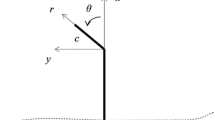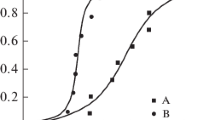Conclusions
A brittle fracture criterion has been calculated for small steel laboratory specimens, in which fracture occurs below the ductility transition temperature after or during the general yielding and microcracks are observed prior to fracture. It is based on the model of interaction between the stress concentration of the initial crack and the near-by slip band for most critical arrangement. The criterion, which does not follow the classical ones, is in good agreement with the following experimental characteristics on tensile and torsional brittle fracture.
-
(1)
The difference in the ferrite grain size dependence of tensile and torsional brittle fracture.
-
(2)
The difference in the plastic deformation prior to fracture in both tensile and torsional tests.
-
(3)
The main macroscopic fracture crack path in tensile and torsional brittle fracture.
Résumé
On a divisé en deux types les ruptures quasi fragiles des solides, c'est a dire les ruptures fragiles qui se produiront sans deformation plastique appreciable. Dans le premier type entrent les ruptures sous contrainte faible qui surviennent, avant écoulement plastique, dans les structures importantes en sollicitations quasi élastiques.
Dans le second se situent les ruptures fragiles de petites éprouvettes de laboratoire en dessous de la température de transition, qui se produisent immédiatement après ou au cours de l'écoulement plastique, et ou l'on observe des mierofissures avant rupture.
Dans chacun des cas, on considère que la rupture ne résulte pas d'un processus simple.
Zusammenfassung
Fast sprode Brüche in Festköpem, d.h. spröde Brüche ohne bemerkenswerte plastische Verformung, warden in zwei Gruppen eingeteill. Zu der einen Gruppe gehört ein schwacher Anspannungsbruch bei fast elastischer, weiter Struktur, welche vor gewöhnlichem Nachgeben vorkommt. Zu der anderen Gruppe gehören spröde Brüche von kleinen Laborationsproben unter der Übergangstemperatur-Dehnbarkeit, welche sofort nach dem gewöhnlichen Nachgeben oder während des Nachgebens vorkommen and wobei kleinste Risse vor dem Bruch beobachtet werden. Es wird in den beiden Gruppen nicht angenommen, dass der Bruch in einem einzelnen Prozess entsteht.
Similar content being viewed by others
References
Part I
D.S. Dugdale,J. Mech. Phys. Solids, Vol. 8 (1960) P. 100.
B.A. Bilby, A.H. Cottrell and K.H. Swinden, Proc. Roy. Soc., Ser. A, Vol. 272 (1963) P. 304.
G.I. Barenblatt, Advance in Appl. Mech., Vol. 7 (1962) P. 55.
A.K. Head and N. Louat, Aust. J. Phys. Vol. 8 (1955) P. 1.
P. Priestner and N. Louat, Acta Met., Vol. 11 (1963) P. 195.
N.I. Muskhelishvili, Singular Integral Equations, N.V. P. Noordhoff, Groningen, The Netherlands (1953) P. 251.
J.N. Goodier and F.A. Field, Fracture of Solids, D.C. Drucker and JJ. Gilman Ed., RIME. Interscience Pub. (1963) P. 103.
J.A.H. Hult and F.A. McClintock, 9th Int. Cong. Appl. Mech., Vol. 8 (1957) P. 51.
A.A. Griffith, Phil. Trans. A222 (1921) P. 180.
Part II
G.T. Hahn et al., Fracture, B.L. Averbach et al. Ed., John Wiley & Sons, (1959) 51.
T. Yokobori and M. Hanzawa, Tech. Rep. Tohoku Univ. Vol. 28 No. 2, (1964) 141.
T. Yokobori and Y. Kitagawa, Symposium paper of the Semi-International Symposium, Japan Soc. Mech. Engr. (1967), Exp. Mech. Vol. II, p. 183.
T. Yokobori and A. Otsuka, Proc. First Int. Cong. Expr. Mech., Pergamon Press (1963) 353.
For tensile fracture, for example; NJ. Petch, J. Iron and Steel Inst. Vol. 174 (1953) 25;
J.R. Low, Relation of Properties to Microstructure, ASM, (1964) 163.
T. Yokobori, A. Otsuka and T. Takahashi, Fracture of Solids, D.C. Drucker and JJ. Gilman Ed., Interscience Pub., (1963) P. 261.
T. Yokobori, Tech. Rep. Tohoku Univ. Vol. 28 No. 2 (1964) 167.
E. Orowan, Fracture. Averbach et al.. Ed., John Wiley & Sons, (1959) 147.
A.K. Head and N. Louat, Aust. J. Phys., Vol. 8 (1955)1.
R. Priestner and N. Louat, Acta Met., Vol. II, (1963) 195.
N.I. Muskhelishvili, Singular Integral Equation, N.V. P. Noordhoff, Groningen, The Netherlands (1953) 251.
G.I. Barenblatt, Advances in Appl. Mech., Vol. 7, (1962) 55.
R.D. Heiaenreich et al., J. Appl. Phys., Vol. 18, (1947) 1029.
B.L. Averbach, Pro. 1st. International Conference on Fracture, 1965, Sendai, Vol. 2, (1966) 747; also Intl. J. of Fracture Mech., Dec. 1965.
T. Yokobori, T. Takahashi and H. Kishimoto, Tech. Rep. Toboku Univ. Vol. 28, No. 2, (1964) 153.
Rights and permissions
About this article
Cite this article
Yokobori, T. Part II. Brittle fracture with interaction between elastic crack and near-by slip band. Int J Fract 4, 188–205 (1968). https://doi.org/10.1007/BF00188947
Received:
Issue Date:
DOI: https://doi.org/10.1007/BF00188947




